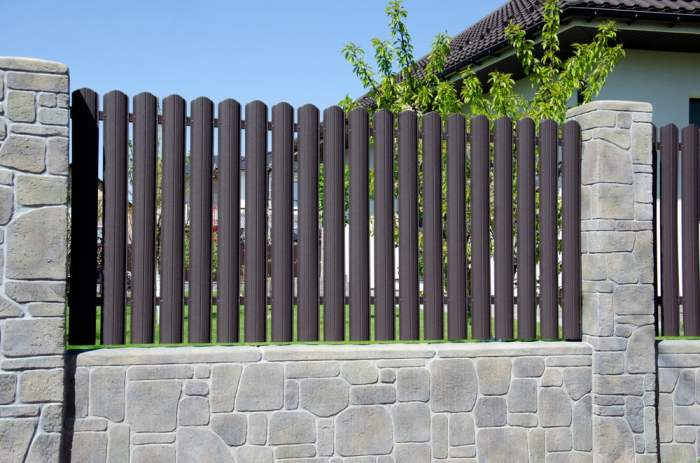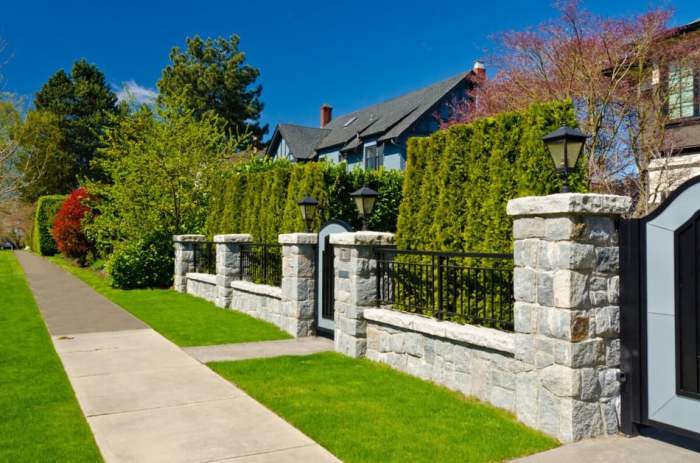Stone wall and fence – Stone walls and fences have long been integral elements in landscaping, adding a touch of timeless elegance and functionality to both residential and commercial properties. From defining boundaries to creating stunning focal points, these structures offer a wide range of design possibilities.
In this comprehensive guide, we delve into the world of stone walls and fences, exploring their diverse applications, design considerations, and maintenance techniques. Whether you’re a homeowner looking to enhance your outdoor space or a professional seeking inspiration, this guide provides valuable insights and practical advice.
Stone Wall and Fence

Stone walls and fences are enduring and versatile landscaping elements that can enhance the beauty, functionality, and value of any property. They are made from natural materials, making them environmentally friendly and sustainable.
Stone Wall Design and Construction

Stone walls are typically built using one of three methods: dry-stack, mortared, or veneer. Dry-stack walls are built without any mortar, relying on the weight and interlocking of the stones to hold them in place. Mortared walls use mortar to bind the stones together, creating a more solid and durable structure.
Veneer walls are built by attaching a thin layer of stone to a backing material, such as concrete or brick.
Stone walls can be designed in a variety of shapes and sizes, including curved, straight, and terraced. Curved walls are often used to create a more organic and inviting look, while straight walls are more formal and traditional. Terraced walls are built on a slope, with each level creating a flat surface that can be used for planting or seating.
The materials used to build stone walls vary depending on the region and the desired look. Some of the most common materials include granite, limestone, sandstone, and fieldstone. The stones should be chosen for their durability, strength, and resistance to weathering.
Stone Wall Applications
Stone walls have a wide range of applications in landscaping, including:
- Retaining walls: Stone walls can be used to retain soil on slopes or to create raised beds for planting.
- Boundary markers: Stone walls can be used to mark property boundaries or to create a sense of enclosure.
- Decorative elements: Stone walls can be used to add beauty and interest to any landscape.
Stone Fence Design and Construction

Stone fences are similar to stone walls, but they are typically built with smaller stones and are not as thick. Stone fences are typically used to mark property boundaries or to enclose animals. They can be built using the same methods as stone walls, but they are often built with a post-and-rail design.
Post-and-rail fences are built by setting posts in the ground and then attaching rails to the posts. The rails can be made from wood, metal, or stone. Post-and-rail fences are a popular choice for rural areas, as they are easy to build and maintain.
Stone Fence Applications, Stone wall and fence
Stone fences have a variety of applications in landscaping, including:
- Property boundaries: Stone fences can be used to mark property boundaries or to create a sense of enclosure.
- Animal enclosures: Stone fences can be used to enclose animals, such as horses, cattle, or sheep.
- Decorative elements: Stone fences can be used to add beauty and interest to any landscape.
Stone Wall and Fence Maintenance

Stone walls and fences are relatively low-maintenance, but they do require some occasional care to keep them looking their best and functioning properly. Here are a few tips for maintaining stone walls and fences:
- Clean the stones regularly to remove dirt and debris.
- Repair any cracks or damage to the stones as soon as possible.
- Seal the stones to protect them from the elements.
Question & Answer Hub: Stone Wall And Fence
What are the key differences between stone walls and stone fences?
Stone walls are typically thicker and taller than stone fences and are primarily used for structural purposes, such as retaining soil or marking boundaries. Stone fences, on the other hand, are typically thinner and shorter and are used primarily for decorative purposes or to enclose areas.
What are the different types of stone walls?
There are three main types of stone walls: dry-stack, mortared, and veneer. Dry-stack walls are constructed without mortar, relying on the interlocking of stones for stability. Mortared walls use mortar to bind the stones together, providing greater strength and durability.
Veneer walls are constructed using a thin layer of stone attached to a backing material, such as concrete or brick.
What are the benefits of using stone walls and fences in landscaping?
Stone walls and fences offer numerous benefits, including durability, low maintenance, aesthetic appeal, and increased property value.
How can I extend the lifespan of my stone walls and fences?
Regular cleaning, repairs, and sealing can significantly extend the lifespan of stone walls and fences. It’s important to remove dirt and debris, repair any cracks or damage, and apply a sealant to protect the stone from moisture and weathering.
